|
JET
HYDROFOIL SHOOTS AT WORLD RECORD
It was during the New York Boat Show of 1952 the
public first heard about Frank and Stella Hanning-Lee.
On the floor at the Old Madison Square Gardens, where
the Boat Show was held, was a stunning hydrofoil boat
obviously designed for high speeds. Yet the story
of the Whie Hawk it's driver and team members has
somehow been overshadowed by the record breaking
community. This is such a shame because it reads
like a film script, includes a fascinating cast of
characters and would indeed make a Howard Hughes (leonardo
di Caprio) style film in typical Hollywood
style. It has it all. A dashing war hero, a glamorous
heroine, secret technology, espionage, intrigue, action,
dramatic accidents and a cruel twist in the tail.
What a thriller!
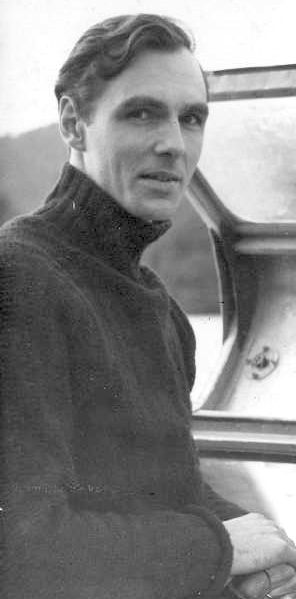
Frank
Hanning-Lee
The
British couple aimed to break the speedboat record
with their jet-powered craft, the White Hawk, on
Lake Mead, Nevada in the fall. The man-and-wife
team collaborated on the design. Mrs. Henning-Lee (an
American by birth) is the driver.
They
have made a hobby of hydrofoils and that is the basis
for their craft. The hydrofoils correspond to the
airfoils or wings of an airplane, lifting the hull
clear of the water to reduce drag at high speeds.
Since water is denser than air, the wings can be much
smaller. The 20 foot White Hawk has a 12-foot
beam. Its Rolls-Royce Derwent jet airplane engine
develops 4000 horsepower.
In
1951, work was in progress on the White Hawk
(registered K5), the jet-powered hydrofoil of a
former submarine lieutenant in the British Navy called
Hanning-Lee. Supported by his beautiful 28-year-old
wife Stella, Frank Hanning-Lee may have inherited the
blind daring of his ancestor, Horatio Nelson, when he
decided to embark on the highly experimental task of
fitting a 1943 Whittle turbojet engine of 2,000 lb.
thrust into the cigar-shaped fuselage of a hydrofoil
configuration, and take a patriotic crack at the water
speed record.
A
propeller-driven boat tends to lift its bow because of
the low position of the thrust. A jet boat tends to
push its bow down into the water (obviously depending
on the aim of the exhaust). To overcome this tendency,
the designers broadened the forward hull. At top
speeds, the hydrofoils keep the nose from burrowing
into the water. It would not have been a giant
leap to have made the lowest foil into a planing shoe,
as used on the Bluebird K7 a few years late by Ken
Norris.
In
the September of 1951, having collected a substantial
amount of data about hydrofoils from both the
Admiralty and Professor Christopher Hook of the
Hydrofoil Association, the Hanning-Lees invited Ken
Norris 'to do their sums for them' and before long
Norris found himself doing the entire design work
himself, until he realised that he was not going to be
paid for his labours.
The
25 ft White Hawk was built and after flotation
and engine tests out on the sea at Margate and on the
Thames at Tilbury, the £14,000 hydrofoil was
transported up to Lake Windermere for trials in the
August of 1952. Apart from a fortnight in September
when they went south to replace the old engine with a
Rolls-Royce Derwent Mark V unit, the Hanning-Lees
stayed at Windermere for three months but were totally
unsuccessful in getting their craft to lift at speeds
much over the 70.86 mph, which Graham Bell's
Hydrodome IV had set up over thirty-three years
before.
Another
Englishman, John Cobb, went after the record in a jet
boat in 1952 and was killed when it exploded during a
speed run. His boat was a flat-bottomed hydroplane
with heavy surface drag. The Henning-Lees say their
hydrofoil design eliminates this danger. But are
there other limitations?
The White
Hawk had
a beautifully made all-aluminum hull. The steel foil
system consisted of a full span U-foil forward and a
single tail foil aft. The aft strut-foil assembly was
steerable. The hull looked like an airplane fuselage and
was wrapped around a Rolls Royce Derwent jet engine. The
Derwent gave the craft a thrust-to-weight ratio greater
than one, so all you had to do was point it skyward and
you had a rocket! The hull contained a single seat cockpit
forward of the gas turbine.
It was advertised that the craft had been brought
to the United States from England with the objective
of seeking the world's speed record for marine craft.
At this time the US Bureau of Aeronautics was
interested in hydrofoils to be used to improve the
landing characteristics of seaplanes in rough water.
Some experimental work was underway funded by the
Bureau and managed out of the Office of Naval
Research. It was decided that the US Navy would make
an investigation into this particular craft and as
Hydrofoil Project Officer, I was given the task of
looking into the vehicle.
Bill Carl (then with John H. Carl and Sons of Long
Island) and Tom Buermann (of Gibbs and Cox) were two
New Yorkers involved with the hydrofoil program. Upon
contacting them regarding the Boat Show hydrofoil,
they both reported that they had seen the craft and
that the owners and operators were Mr. and Mrs.
Hanning-Lee, from England. Both Bill and Tom had
talked with the Hanning-Lees and had learned that they
wanted nothing to do with the US Navy. They were
seeking commercial support and were convinced that
they would be well paid for their efforts. They of
course expressed interest in obtaining any
contributions that Gibbs and Cox or John H. Carl would
care to make.
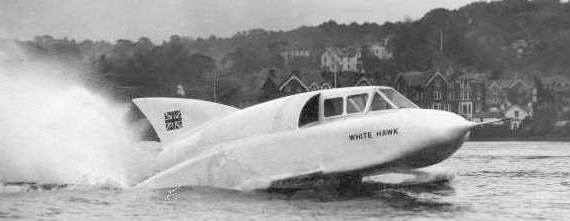
Frank
was born
into a naval family and educated at Stowe school not
far from the Silverstone grand prix
circuit. At the time Stowe was a fairly
new establishment, former pupils included actor David
Niven. Young Frank was a boarder and studied the
classics, to include Greek and Latin, which is
surprising considering his
later career. He really wanted to be an
engineer not a sailor, but he parents got their way and
in 1937 Frank signed up for a cram course
to teach him all the things he would have learned at Stowe. He was a bright student and came out
top of the class of twenty. Out of those 20
classmates, the other nineteen apparently lost their lives in the
war.
Having joined a ship, Hanning-Lee saw service in
Singapore at the time when Japan was about to invade
and later in submarines before embarking on the
hazards of convoy escort duty to and from the USA. It
was on one of these trips that he met his future
wife.
His
wife Stella was previously a cost-accountant at the Quincy ship yards, near Boston.
She was a striking, attractive,
brunette with a cultured accent and a
strong personality. Their first son, Vaughan,
remembers that his father was very much an ideas-man.
Frank was always inventive,
and loved new technology. He saw the big picture
at the expense
of the day-to-day practicalities. His wife by contrast was very
practical and determined. She was the sort of
character who would push a project along from drawing
board, driving through whatever obstacles got in the
way. Stella is also described as statuesque, with long blond hair and a very business like
attitude. Both had strong British accents and used quite
cultivated English. Mrs. Hanning-Lee
had been born and raised in Connecticut. She met the
Commander during the war, married, and wet to live in
England, where she quickly developed a thick
English accent.
At some point during his naval service,
Lieutenant Hanning-Lee, was inspired by a captured German
torpedo boat which featured hydrofoils to lift it
clear of the drag-inducing water. Frank kept
this in mind and wanted to use the idea in peace time
for a commercial flying boat. I think we can all see
the attraction in that.
Being somewhat impatient by nature he bought
himself out of the Navy 12 months short of his 10 year
service and not only cost himself a good deal of money
but forfeited his future pension rights. Vaughan
Hanning-Lee recalls that this was very much in the
spirit of the time, his father having survived active
service throughout the war when so many colleagues had
perished.
Once in civilian life he went into business, backed up
and pushed forward by Stella, running ex army DUKW
amphibious trucks as a ferry service to and from the
Isle of Wight. Later a boat was built to complement
them, the 220 seat Island Princess. Finance for all of
this probably came from the legacy left to Frank
by his late father in 1947. That same
legacy allowed him to set off on his next
venture, a stepping stone for the promotion of hydrofoils in readiness for
the aircraft he eventually planned to construct - the
White Hawk.
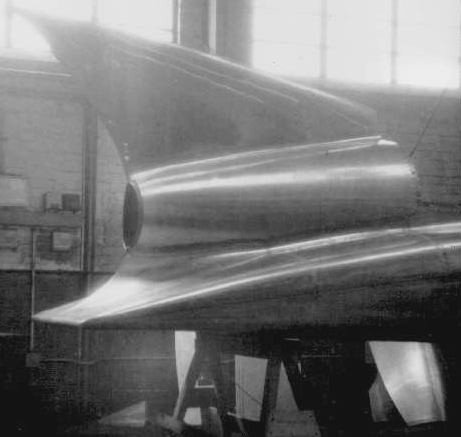
Frank
reckoned that speed record projects gained a
huge amount of publicity at the time and that such a
project would also give credibility to his future
plans and influence potential backers.
Logically, he decided on
attacking the water speed record, which at the time
was held by Sir Malcolm Campbell in the Bluebird
K4 hydroplane, itself something of a British military
secret. The record set by Sir Malcolm in 1939, stood at 141 mph but was
soon to be
broken decisively by Stanley Sayers in the
USA, who pushed the goal posts to a little over
160 mph.
EXPERT
ASSISTANCE
With
his admiralty contacts he was able
to bend the ear of a professor in the west country who
was studying foils for the Navy. Frank went along to
see him and came away armed with performance graphs
and charts which he could base the foil designs upon.
He also touched base with Professor Christopher
Hook of the Hydrofoil society and so acquired more
vital data, some of which was probably a state secret at the time.
However Hanning-Lee, despite his interest in things
mechanical was not a trained engineer and having
conceived a basic layout for the boat contacted
Imperial College, London, to see if they might help
him work out the stresses and structures involved. He
contacted Professor Tom Fink, who in turn passed him
over to a promising student of his who had come to
Imperial after wartime service with Armstrong
Whitworth. This student had worked on projects that
included the top secret "flying wing"
aircraft, his name was Ken
Norris, future designer of both Bluebird K7 and
CN7.
Ken
Norris tells the story in his own words: "Hanning-Lee wanted
some stressing done. So I went along to his
town house, in Chelsea I think, and met him. He took
me into the cellar and showed me some performance
charts and calculations he had got hold of and an
outline drawing of this boat on the wall, complete
with a sharks fin on the top. He said 'Can you stress
that?' and when I said 'Where are the plans?' he just
pointed to the drawing and said 'That's it'. I told
him I needed structural plans to work from - but he
hadn't got any, just this outline. He said 'Can you
draw them for us?' and that's how it started".
Working to the basic concept before him, Ken drew
up a steel square-tube frame clad in aluminium with a
two seat, tandem-style cockpit ahead of the jet
engine, a sleek pointed nose and foils borne on
outriggers either side of the intake. Ken said: "I didn't
know much about hydrodynamics, I was into aircraft and
aerodynamics, my brother Lew was the marine expert so
I asked him and he helped out. I was working for
Hanning-Lee, Lew was already working for Donald
Campbell (on the prop-riding K4) so we were in rival
camps, but he still helped out and so we got on okay with the design".
Ken also used a steel frame and aluminum body for his
Bluebird K7 design.
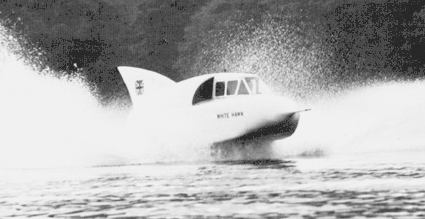
Frank Hanning-Lee
General consensus has it that Accles & Pollack
built the main framework, probably for a very
advantageous price. When it came to panelling the
boat, the Hanning-Lee's employed a small family firm,
Brownlow Road Sheet Metal Co. based in Willsden. The
company was run by Bert, Harold & Alan Noble and
their day-to-day work consisted of building hearse
bodies!
Vaughan
Hanning-Lee believes that his parents had a deal with
Accles & Pollack to build the hull for a very
advantageous price, maybe even free, but the press of the
day still made hay of the fact it had cost the Hanning-Lees
some £14,000 to get WHITE HAWK to the point of making a
run. During the build, Vaughan also recalls that some work
was done by Bob Sellars, exactly what it was he isn't
sure, but Bob Sellars went on to design part of the
Lightning fighter plane. White Hawk certainly didn't lack
for designers with "the right stuff"! When
complete the craft was floated at Tilbury docks and a
static engine test performed. Then it was loaded onto a
truck which headed north to the lake district. At this
time John Cobb was making the same trip but his boat,
Crusader carried on past the lakes to Loch Ness where he
began extensive test runs. It's interesting that both
boats are exact contemporaries but also that White Hawk was registered as K5 and Crusader as K6. If one assumes
the first non-aircraft use of a jet engine was in
Campbell's unsuccessful Goblin-powered Bluebird K4
"slipper" in 1946-47, White Hawk must rank as
only the second such use and Crusader as the third -
something close to a decade before the concept was applied
to a pukka land speed record vehicle.
In his book
'Water Speed Records', historian Kevin Desmond quotes the boat as using an early Whittle
engine dating from 1943. However, Vaughan Hanning-Lee
is quoted as remembering his father talking of the original Whittle
engine, and there is a photo showing such an engine sitting in the
rear of a space-frame nearing completion, the design of
Ken Norris. Vaughan also confirms that at
some point an approach was made to Rolls Royce about
supplying something more up to date, on the pretext
that any record breaking would be good PR for them
too. It appears the suggestion was persuasive
since not only were Frank and Stella given a Derwent engine, but
they also got a spare,
and a couple of mechanics to work on the engines when
needed.
The team arrived at
Windermere on the weekend of the 17/18 August 1952 and
encountered immediate problems with getting the boat off
the transporter and actually into the water! It took until
Tuesday when a mobile crane was employed to lift it bodily
down into the lake at Bowness pier head, some 500 yards
from it's boathouse. Amid great excitement the engine was
fired and Frank took the controls. This was just a systems
test and the surface was choppy, but he motored the White
Hawk out from the pier a short distance, plumes of spray
almost engulfing it, before cutting the engine. Pushing up
the cockpit cover, he stood up in the seat he waved a
launch over to tow him back as the swell was stronger than
expected. Later in the day the boat was towed across to
the far bank where the trees shielded the wind a little
and a further short run of a few hundred yards was made at
low speed. "It was far too rough ... I doubt whether
I managed to get above 60 mph" he later told the
press. Another run was planned for the following day -
weather permitting. This time White Hawk gave the press
men something to write about when it made a two mile run
with Stella at the controls and Frank in the back-seat.
This was potentially big news, a woman at the wheel of
such a radical craft - not only that but she was young and
glamorous and happened to be American into the bargain!
One can envisage the stir this must have caused in Fleet
Street and indeed there was no shortage of press men on
hand to witness the drama.
Geoff Hallawell, a
regular member of the Bluebird crew from 1949 onwards was
among them, in his capacity as a press photographer.
Hallawell recalls the boat's performance with a chuckle. "it
never actually got going at any speed, it sort of
porpoised up and down with big clouds of spray. He never
saw it go faster that 50 mph. Apparently the
Hanning-Lees did not warm to Geoff, he says they viewed
him with a degree of suspicion and were rather unfriendly,
but admits that his association with Donald Campbell's
team - their direct rival, was probably the cause. Hallawell
recalls that there was a degree of American media
interest in the project, thanks to Stella. This spurred
Associated Press to send along their own cameraman, Les
Priest and Movietone News also saw the potential of the
effort, sending their north-west cameraman Jimmie
Humphries to cover activities on the lake.
Movietone had
once been edited by Sir Malcolm Campbell of course, so
they were naturally always interested in record attempts.
What happened next certainly justified their presence.
Frank took over the controls, Stella alighted and White
Hawk splashed off up the lake again amid clouds of spray
then suddenly at around 60 mph hit the wake of a pleasure
steamer that was moving around. Onlookers saw the sleek
white jet boat suddenly dive headlong into the water and
completely submerge! It bobbed under the surface
swallowing a large volume of water as it did so but
amazingly bobbed back up again, intact! Vaughan Hanning-Lee
recalls his father telling him how it went suddenly quiet
and seemed to take for ever to resurface! The reported
"thousands lining the shores" watched as
launches rushed out to offer assistance. It seemed to be
sinking again, rather slowly, and Frank feared the hull
had been holed. Rapidly a line was attached to tow it back
to the pier. It was a 300 yard trip and they succeeded in
dragging it into the shallows before it actually went
under for the second time.
Reports have it that the craft
was effectively beached in some four feet of water. Ken
Norris, on reading a newspaper clipping of this incident
commented that the boat shouldn't have been run at all if
other craft were moving on the lake, but that it was very
much in the gung-ho spirit of the times that Hanning-Lee
had simply "had a go". In fact it is unclear
what form of team ran the boat, if any. Its possible that
they were reliant on eager locals for the most part to
provide launches and general help with launching White
Hawk, and probably their Rolls Royce mechanics to keep it
running. A later press report mentions "the mechanic
worked until 1am the get the boat ready", giving the
impression that it was something of a one-man operation!.
Certainly there seems to be no record of any organised
troupe of helpers.
A careful check of the
boat was made after it was finally retrieved and Frank
reported "There is no damage done and she will dry
out in a couple of days" but in fact a couple of
large dents were found near the prow and another along the
starboard side which needed repairing. The press had been
told Stella would be making a full out attempt on the
record the following Saturday but the incident effectively
ruled that out. Things then went quiet. The boat was taken
off the lake and repairs and sundry modifications began.
The weather also turned sour - as it always seems to when
any form or record attempt is in progress!
In the meantime Cobb
was undergoing tests on Loch Ness and making good progress
- then disaster. The Crusader nose-dived into the lake and
exploded during the official record attempt and Cobb died
of his injuries. Doubt was cast over the White Hawk
project. Vaughan recalls a lot of reporters hanging around
for a quote, sure that everything would be called off, but
it was announced that the Hanning-Lees would indeed be
going ahead with more trials as soon as the boat and the
weather were in a suitable state to continue. Fatal
accidents in the early 50s were not seen in the same light
as they are today.
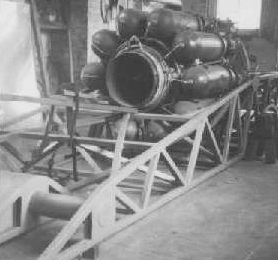
White
Hawk's frame and jet engine
News reports dried up
until early October when Stella was said to have made a
100 mph run but experienced severe "porpoising"
which would require more modifications and a further 5
days to fix as work was carried out not at Windermere, but
in Barrow. On the 18th The Times reported that a new
Derwent engine was being fitted with 6000hp available.
When this was completed the weather had again gone sour
and after only one test run with the new unit in early
November, Frank was quoted as saying he would have to wait
until the lake had been combed for driftwood before more
trials could take place, assuming the weather improved and
the wind dropped. The modifications carried out at Barrow
were said to have cured the porpoising and he denied
stories that they would soon have to pack up and head
south for the winter. Young Vaughan had been attending the
local school and the family had been living in various
local hotels. Almost four moths had now passed since the
early runs, the press had largely gone home, the weather
was unrelentingly dreadful - if it hadn't been strong
wind, it had been fog or rain that caused endless
postponed runs -and money, as always, was running low.
Despite earlier statements Frank & Stella went back to
London in late November, returned briefly in early
December then announced the venture was being put on hold
until at least Easter in the hope of better weather.
FUND
RAISING and the US NAVY
Navy
personnel arranged to meet with the Hanning-Lees to
propose an association, but the couple got the wrong end
of the stick and were somewhat mislead as to the intent of
the meeting, believing private money was being offered -
they rejected any notion of a tie up with the Navy.
Some time went by before we heard anymore about the White
Hawk or the Hanning-Lees, perhaps about three months.
The Hanning-Lees eventually contacted Bill Carl to
rekindle negotiations. Apparently their campaign to raise
funds had not been very successful, having only secured fuel to power the craft for a
speed attempt. They asked Bill Carl if they could
anticipate any support based on our conversations at the
Grammercy Hotel. At which point Bill confessed to
the couple that the meeting had
been an attempt by the US Navy to learn more about them
and their craft. He further revealed to them that a
colleague was a
Naval Officer in the assignment of Hydrofoil Project
Officer with the Office of Naval Research. At this
point the Hanning-Lees said that they no longer had any reservations
about Navy support.
Washington decided to
try and get Frank to make a demonstration run. The
Navy's
proposition was that if the Hanning-Lees would furnish the
craft and pilot, the Navy would pick up the expense for
the other costs for a run over a measured mile. Then, if they
exceeded a speed of 100 miles per hour, the Navy would be
interested in talking to them about a test program. The
Hanning-Lees agreed to this without hesitation, and who
can blame them. It constituted a genuine offer of
sponsorship. Accordingly, the Navy put some extra funds
into what became known as the " John H. Carl and Sons" contract, with Bill
Carl as project manager. Work began on the measured
course shortly thereafter.
Then
the troubles began. After agreeing terms, the Hanning-Lees
confessed to the Navy that they had never run the craft.
Apparently, in
their eagerness to get to the USA to raise funds, they had
left England as soon as the craft was completed. They
didn't even know the last time the turbine had been run,
hence aircraft mechanics would be needed to get the engine
working. The newly formed team sought
help from
Grumman Aircraft, and in particular from Jake Swirbul,
a founder and then president of Grumman. Fortunately, Jake
offered the assistance of not one, but two mechanics.
Since this was for the Navy he even stated that there
would be no cost.
The location chosen for the measured mile was near
Eaton's Neck on the northern shore of Long Island. Here
there was sheltered water and the availability of the US
Coast Guard to assist in the event. The more the team learned
about the craft, the more they became concerned about the
safety of the pilot. There were no instruments on board to
give an indication of speed. Even the turbine's
instrumentation was limited. Further, when the pilot
closed and secured the overhead hatch, it could only be
opened from the inside - so if the pilot was unconscious,
it would be a problem. For this reason the Coast Guard agreed to furnish
a helicopter with a rescue crew on board, with an
axe to break the pilot out in the event of an accident. The
Coast Guard also furnished other boats along the measured
mile to mark the course and for rescue assistance
if required.
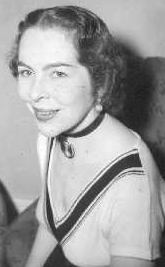
Stella
Hanning-Lee
By now the news of the
event had spread throughout the hydrofoil community, and
on the day of the trial about a hundred hydrofoil
enthusiasts had
gathered on Long Island. At last the great day had arrived.
The team selected an early
morning run as the winds were lighter and the sound was
calmer. By about 0630 everyone and everything was in
place.
The night before the trial was most interesting.
The US Navy team had dinner with the Hanning-Lees and the
subject was, ' who would pilot the hydrofoil'. Since both of the Hanning-Lees
were capable. The discussion that followed revealed the
concern both had for the safety of the venture. They
discussed openly who would be the
pilot. Finally, it was decided it would be best for
Commander Hanning-Lee to make the run because in the event
of an accident, Mrs. Hanning-Lee would be able to take
care of their son.
The
Commander was in the White Hawk with the turbine
running nicely about a quarter of a mile before the marker
boat, the start of the measured mile. The signal to go was given and for the
first time White Hawk was underway on its own
power. The craft quickly picked up speed and was
foil-borne
well before reaching the start of the mile. The vessel hit
the start line well up on its foils, running quite stable,
and from the sound of the turbine seemed to be near full
power.
For the next quarter of a mile
the boat appeared to be handling nicely, when all of a
sudden the boat disappeared in
a cloud of white spray. Thankfully, White Hawk
and driver
emerged from the mist afloat and in one piece. Frank
opened the hatch and climbed out quite calmly. But
after the excitement of the halt died down, it emerged
that Frank had no idea of the speed he was going at.
The speed at which the water seemed to be coming at him in
that small space, without any feedback dictated he should
throttle back, if rather suddenly. It seemed like the
sensible thing to do.
A
post-run examination of the craft revealed that everything
was intact except the turbine had ingested quite a bit of
water. This necessitated cleaning before any more running.
Hence, events were called off for the day, and the attempt was
rescheduled for the following morning. The Grumman
mechanics worked diligently through the day and night to
clean the turbine and by dawn the next day the craft was
ready to go. However, the winds had come up over night and
the water over the course was rough. So delaying
testing. Due to the spiraling standby costs the Navy representatives decided that
they could no longer keep the wait going and
called off the trial at Eaton's Neck. However, the
Navy had seen enough
in that short time to want to pursue the matter further.
Thus, the Navy asked Frank and Stella to come forward with a proposal
to permit the Navy to conduct trials at Patuxent Naval Air
Test Center.
Roughly three weeks later, the Hanning-Lees arrived in
Washington with a proposal and brought with them a very pushy lawyer.
Although they didn't know it at the time, their
proposal far exceeded the Navy's budget. The
proposal put forward was based
on an achieved mile per hour basis demonstration. Each
time the speed exceeded certain performance thresholds the
mph cost went up considerably. The cost of
reaching 125 miles per hour along with the living costs
and salaries for both of the Hanning-Lees worked out more
than the US Navy had available. However, instead of
negotiating,
the pushy lawyer demanded an immediate contract. That
had the effect of putting the Navy off and the discussion was
halted. Also, the interest in hydrofoil sea planes was on
the wane. It was just bad timing and the opportunity was
not to come again. Though after cooling off the Hanning-Lees called
the Navy and said they
would be willing to accept any reasonable proposition the Navy would make,
it was no go. It appears they had been overconfident
of their saleability.
RESTING UP
The boat was being stored
at a service station in Silver Spring but even that was
costing more than the Hanning-Lees could afford so it went
back to Stella's mother's in Boston. Popular Mechanics ran
a feature in August 1953 in which it was said to have run
125 mph in England. This is almost certainly not true.
Kevin Desmond quotes no more than 70 mph was recorded and
here we come to the crux of the matter. Ken Norris says
that later experiments with foils showed that above a
certain speed (70-80 mph) the foil "cavitates".
In effect it builds up a low pressure area over the top
surface of the foil and at a given speed this causes the
water to break away from the surface of the foil, much as
an aircraft wing would do in a stall situation. This ruins
the lift, two thirds of it would suddenly vanish and cause
the whole thing to fall back down into the water abruptly.
The foil is designed to run in the water, unlike a
hydroplane and it simply cannot do it's job with the
stall-effect that eventually builds up. Ken says that this
was not appreciated at the time as nothing with foils had
gone anything like as fast as White Hawk. The
experience gained from the craft was therefore very useful
in learning hydrofoil limitations.
This would explain the
porpoising effect that the craft exhibited on Windermere
and may also explain the abrupt end to the Navy trial run.
Where Frank is presumed to have bottled out, what may have
happened is that the boat reached the cavitation point,
fell back into the water and, mindful that any flaw might
ruin a potentially lucrative agreement, Frank may have
decided to shoulder the
blame rather than admit there was a problem with the
design.
It's possible he did
lose his nerve but for a man who had seen so much action
in the war, already experienced one near disaster and
still gone ahead with other runs as if nothing had
happened, this seems out of character. Further to that we
only have the late Bob Johnson's story of the Navy tests
to work from (published on an Internet site) and it's
clear that he wrote the story from memory, some of which
is bound to be rather hazy with the passing of almost 50
years. He states for example that the boat had been built
by the British aircraft industry, that it had never been
run and that it was a single-seater, all of which is
grossly inaccurate. Readers may decide for themselves if Frank
Hanning-Lee lost his nerve, or that
the boat suffered from cavitation as Ken Norris has
predicted.
The Hanning-Lees did
venture out to Nevada and stayed at the Sahara Hotel on
Las Vegas while trying to arrange a run on Lake Mead but
nothing came of this and they returned to Boston and
worked hard to save enough money for a return to Britain.
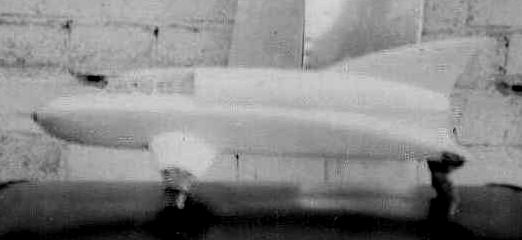
A
model of White Hawk
BANKRUPT
They had gone broke in trying to
promote their craft and didn't have enough funds to return
them or their craft to England. They had both taken jobs
in retailing to keep their son in school and to save
enough to go home. It seems that on return to England,
they could not afford to pay the import duty then payable,
since the boat had been out of the country of origin for
some time.
Frank finally made it back to Southampton, bringing back
the
boat as cargo in 1954. On arriving he was hen hit by the final
twist of fate - he hadn't the funds to get the White
Hawk through customs! How this situation came
about is unclear, but we can guess there was some rule
about time out of the country. The customs and excise impounded the boat and that is the
last anyone heard of it. Inquiries at the Customs House in
Orchard Place Southampton, yielded a polite and immediate response, that records relating to this period in time have
long-since been destroyed. The department said there
was no
chance of the boat lying undiscovered in the corner of a
warehouse, as the entire docks had been rebuilt since the
50's. It is presumed the craft was sold for
scrap. However, we all know how military secrets are
kept locked away.
Stella and Vaughan
arrived by air some weeks later and picked up the pieces
after their transatlantic adventure. Frank went ahead with
his flying boat idea and contacted Tom Fink at Imperial
once again, but the plane never got off the drawing board.
The experience gained in fibreglass work stood Frank and
Stella in good stead in their later business ventures.
Frank outlived his wife and died in late 1998. Vaughan
went on to study aeronautical engineering at Queen Mary's
while younger brother Mark works in California as a
computer software writer for industry.
The
moral of this story is, if you are considering doing
anything so outrageous, you will go down in the history
books, but nobody will know the personal hardships you may
have suffered along the way, unless you either find
sponsorship, take a record, or die in the process.
Almost all record breakers suffer financially. The
few who didn't, were already wealthy before they started.
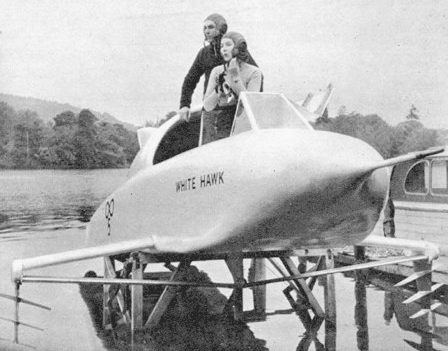
The
Hanning-Lees - James Bond takes a back seat
Ken
Norris, who pulled out of the project before the craft
went up to Windermere, explained what happened:
'I
concluded that above a speed of 70 mph, the hydrofoil
would be subject to cavitation. Unlike a hydroplane,
which generates lift by being on top and skating over
the surface, the hydrofoil is immersed fully, generating
lift on both the top and the bottom surface. As the
speed increases, so the pressures round the foil change
until eventually the pressure on the top surface can
become so low that the aerated water tends to create a
complete bubble and break down the lift on the top
surface. At that point one might lose as much as
two-thirds of the lift and at that speed the vessel will
drop back into the water. So it rides up for a start,
gets up to surface speed and then drops down, rather
like a stall with an aeroplane. I believe that this is
what happened to the White Hawk, although this
doesn't mean that their achievement wasn't pretty good.'
The
most cynical comment about the project was that the
Hanning-Lees were really waiting for Lake Windermere to
freeze over so they could then perform on ice-skis!
The sad thing
about all this, is that White Hawk could never have
achieved the outright record as a foil rider, the laws of
physics were simply not going to let it - Ken Norris had
been right. Perhaps the Hanning-Lees should have
been content with the hydrofoil class record!
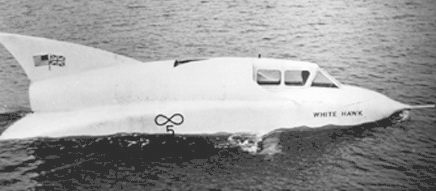
White
Hawk docking
PRESS
REFERENCES CHRONOLOGY
White
Hawk, the £14,000 jet-propelled speedboat, was beached on
the shore of Lake Windermere yesterday. It had
bounced wildly after hitting the wash of a pleasure
steamer while travelling at over 60 m.p.h. in the middle
of the lake.
The
cockpit went under the water as the boat dived nose
first. It bobbed up again and the pilot, ex-naval
officer Mr. Frank Hanning-Lee, climbed out and got astride
the fuselage. Thousand lining the shores saw
pleasure boats secure a rope and tow the White Hawk
300 yards to be beached in 4 ft. of water.
Slight
damage
A
crane lifted the boat out of the water after Mr. Hanning-Lee
and holidaymakers had pumped water from the hull. There
was only superficial damage. Mr. Hanning-Lee said:
"I expected to find a hole. When I struck the wash
water entered the air intake and caused the boat to slew
round and dive.
"It
will take only about a couple of days to dry her out as
the fresh water will not have damaged the engine. Then we
will have another go" The White Hawk was on a
second trial run.
Mr.
Hanning-Lee had taken over from his wife, Stella, who had
piloted it on a two-mile burst.
She
hopes to beat the world water speed record of 178.4 m.p.h.
(The
Daily Graphic, August 21, 1952)
Jet
Boat Takes A Dive At 70 M.P.H.
This
jet-propelled boat was tearing across Lake Windermere at
about 70 m.p.h. yesterday when it began bouncing wildly
over the swell. Before the driver could slow down the boat
dived under the water. It re-appeared almost immediately
but began sinking slowly. Pleasure boats rushed alongside
and the waterlogged boat was towed to the beach. On
Saturday, with Stella Hanning-Lee, 28, at the controls, it
was to have made an attempt on the world water speed
record — 178.49 m.p.h. — held by America. Frank
Hanning-Lee, Stella’s husband, was driving at the time
of the accident. He was unhurt. His wife was driving when
this picture was taken, earlier in the day. After the
accident, Mr Hanning-Lee said: "There is no damage
done and she will dry out in a couple of days."
(The
Daily Mirror, August 21, 1952)
Slight
Mishap to White Hawk -
Future trials only in the early mornings
Hopes
were being entertained last night for a start early this
morning of trials on Windermere by the jet propelled
speedboat, White Hawk, preliminary to the attempt
to snatch the world water speed record from America —
178.4 miles an hour.
White
Hawk, new hope of
ex-submarine lieutenant Frank Hanning-Lee and his wife
Stella, was beached on Wednesday night after it had run
into the wash of a pleasure steamer while travelling at 60
m.p.h. Although no mechanical damage was caused, Mr.
Hanning-Lee revised his plans for water trials and
announced that in future he would take the boat out on the
lake only in the early morning hours.
The
speedboat, the first to attempt the record fitted in
hydrofoils, arrived at Windermere last week-end from the
south but launching difficulties held up trial work until
Tuesday when the craft was towed 500 years from its
boathouse to the pier head at Bowness and lifted bodily
into the water by mobile crane.
The
First Run
Weather
conditions were, however, against the trial — carried
out mainly to test the boat's controls after its trip from
the south — and Mr. Hanning-Lee made only a short run to
Storrs Hall.
After
he had turned the boat round only a few yards out from the
shore, Mr. Hanning-Lee pushed back the cockpit cover,
stood up and waved his hands to indicate to watchers that
the water was too rough.
He
did, however, make a second run on the opposite side of
the lake and in the shelter of a wooded shore, but after
covering only a few hundred yards the White Hawk
was towed back in.
Later,
Mr. Hanning-Lee said: It was far too rough to do anything
and I doubt whether I managed to get above 60 m.p.h."
[text
missing] passenger vessel and the violence of the swell
had caused the hydrofoils to exercise a negative rather
than a positive action with he result that they pulled the
boat under the water. At first it was suspected that
the craft had been holed because it sank so quickly. When
the boat was actually lifted from the water it was seen
that there was very little underwater damage apart from
the two fairly large dents near the prow.
These
were caused by the violence of the impact when the boat
struck the water. As for a small dent on the
starboard side of White Hawk, Mr. Hanning-Lee said
"I don't know how that came to be there."
About
the future, he said that the engine would have to be
pumped out and overhauled, but there did not seem to be
serious structural damage requiring attention.
"There is very little damage done and it is just a
matter of drying out the engine," Mr. Hanning-Lee
later added.
Wife
at Controls
Until
the mishap all had gone quite well with the trials. Both
Mr. Hanning-Lee and his wife Stella — who intends to
pilot White Hawk when a record bid is made — have
admitted that very little is known about hydrofoils.
Mrs.
Hanning-Lee accompanied her husband in the cockpit of the
boat and was seen to be at the controls for the first
trial runs. First test was made towards the southern end
of the lake and later Mrs. Hanning-Lee handed over to her
husband and left the boat.
Mr.
Hanning-Lee said that the mishap would not interfere with
plans for further trials.
He
gave no figure of the speed at which his boat travelled
during yesterday's tests.
(Late
August, 1952)
Attempt
On Water Speed Record To Go On
It
was stated yesterday that Mr. and Mrs. F. Hanning-Lee
intend to carry on with their attempts on the world water
speed record of 178.4 m.p.h. on Windermere. At present
their 3,000 h.p. jet-powered speedboat White Hawk
is confined to the boathouse while minor alterations are
being made to the stern hydrofoil.
(The
Times, October 1, 1952)
Record
attempt. Mr. and Mrs. Hanning-Lee in their jointly
designed jet-propelled speedboat at Lake Windermere, where
they hope to set up a new world water speed record when
weather permits.
(The
Telegraph October 6, 1952)
White
Hawk, Jet Challenger, Flashes By — With A 28-Year-Old
Mother At The Wheel
White
Hawk, jet
challenger for the world's water-speed record of 178.49
miles an hour swishes across the waters of Lake Windermere
at more that 100 miles an hour in a test run — with
Stella Hanning–Lee, 28-year-old mother, at the wheel.
She and her husband Frank have been seven weeks at
Windermere. Yesterday it was said there would be a
five-day delay in trials while further modifications are
carries out to try to correct "porpoising"
tendencies of the boat while travelling at speed.
(The
Express, October 10, 1952)
Ready
For An Attempt on the World Water-Speed Record : Mrs. F.
Hanning-Lee With Her Husband Aboard White Hawk on
Lake Windermere.
Mr.
and Mrs. F. Hanning-Lee have been waiting for some weeks
to attempt to raise the world water-speed record in their
3,000-h.p. jet-powered speedboat White Hawk on
Lake Windermere. They designed the aluminium boat
themselves and expect to reach 200 m.p.h. in her. On
October 3 Mr. Hanning-Lee stated that his wife would pilot
the boat when the attempt was made.
(The
Illustrated London News, October 18, 1952)
New
Engine for Speed Boat
A
new jet engine is to be fitted to the boat White Hawk,
with which Mr. and Mrs Frank Hanning-Lee hope to break the
world's water speed record on Windermere. The new engine
is a 6,000 h.p. Rolls-Royce Derwent Mark V. Further
modifications will also be made to improve the boat's
stability at speed
(The
Times, October 18, 1952)
Still
They Wait at Windermere - Bad Weather Delays Jet-Boat
Trials
White
Hawk, Mr. and Mrs. Frank Hanning-Lee's jet-propelled
speedboat, has been confined to her Bowness boathouse all
this wee, because of the rough weather. The boat has not
had a trial since being refitted with a new engine last
week. Mr. Hanning-Lee said yesterday (Thursday) that he is
determined to wait until there is an improvement in the
weather.
Following
the stormy weather there is a possibility of much
driftwood having found its way into the lake. Although Mr.
Hanning-Lee has decided that the course should be
thoroughly "combed" before any trial run, there
remains the fact that larger pieces of timber, when
thoroughly waterlogged, float just beneath the surface and
are invisible from a boat.
(The
Gazette, November 1, 1952)
Mr.
Frank Hanning-Lee who has been waiting at Windermere for
the weather to improve to test the new 6,000 h.p. jet
engine installed in his speed boat White Hawk has
denied rumours that he is postponing trials until next
year and that he and his wife, Stella, intend leaving
Windermere in the near future.
(The
Barrow News, November 1, 1952 )
Water
Record Bid Put Off - Speed
Trials hampered
An
attempt on the world water speed record on Lake Windermere
by Mr. and Mrs Frank Hanning-Lee, in their jet-propelled
speedboat White Hawk, has been postponed. Bad
weather has hampered the trial. Mr. Hanning-Lee, whose
home is in Chelsea, S.W., has not officially abandoned his
record bid, but his friends believe he will soon take the White
Hawk south and return next summer.
(November
10, 1952)
Jet-Propelled
Speedboat in Test Run: The Whitehawk
[sic], which looks like a seaplane, streaking along at 100
miles an hour [sic] on Lake Windermere, England. Test was
made in preparation for the attempt on the world's water
speed record by Frank Hanning-Lee and his wife. The
official world mark is 178.497 m.p.h.
(
New York Times, November 14, 1952)
White
Hawk Trials
Decision this
week-end?
Mr.
Frank Hanning-Lee is expected to return to Windermere
tomorrow (Saturday), but it is not yet known whether or
not he intends to conduct further trials this year with
his speedboat, White Hawk. for a fortnight the
jet-powered boat has remained in the boathouse since
having only one trial run to test her new engine.
Mr.
Hanning-Lee, and his wife, Stella, who was to have made an
attempt on the world's water speed record, came up to
Windermere nearly three months ago.
(The
Gazette, November 15, 1952)
Is
White Hawk winter-bound?
It
now seems unlikely that there can be further trials of the
jet propelled speedboat White Hawk on Windermere.
Rapidly worsening weather conditions have so far prevented
Mr. and Mrs. Frank Hanning-Lee taking the boat on the lake
more than once since further modifications were made at
Barrow and a new engine fitted a week or two ago.
Local
opinion holds that the onset of November makes it far too
late to hope for a calm lake or for any favourable weather
conditions, and while there has been no statement from Mr.
and Mrs. Hanning-Lee, who have been in London for a few
day, it is thought that they will take their craft south
very shortly.
Hitherto
Mr. Hanning-Lee has denied that he and his wife intend
abandoning their attempt on the world water speed record
for this year, but the signs now are that the weather will
defeat them.
(November
15, 1952)
White
Hawk may be "rested" till next year
Although
Mr. and Mrs. Frank Hanning-Lee are still in London, their
jet propelled speedboat White Hawk remains in the
boat house at Bowness, where it was brought from the South
of England for an attack on the world water speed
record. The Hanning-Lees' plans are unknown.
Certainly White Hawk has not been on Windermere for
tests for some time but whether the attempt to set a new
record has been abandoned for this year has not yet been
announce.
November
is regarded as an unfavourable month because of the risk
of mist and, with the advent of chill winds and frost, the
chance that patches of ice may form on the lake
surface. It was reported recently that the Hanning-Lees
might be forced by the weather to postpone further
attempts until next year. This boat has been fitted with a
more powerful engine and has been modified twice since
being brought North.
It
is understood that the Hanning-Lees' young son is
attending school at Windermere.
(Source?
November 29, 1952)
News
in Brief
Mr.
Frank Hanning-Lee said at Windermere on Saturday that he
and his wife had postponed until next year their attempt
to beat the world's water speed record.
(The
Times, December 1, 1952)
Trials
off until Easter Windermere Jet-boat Decision
Mr.
Frank Hanning-Lee returned to Windermere last week-end
when he announce that he and his wife had decided to
abandon trials with their speedboat White Hawk for
this year. The boat is to be ta
ken
south and various adjustments will be made during the
winter, but Mr. Hanning-Lee said he and his wife hope to
resume trials at Easter.
On
Monday, the jet-powered boat was taken up the lake to
Calgarth where she was hoisted on a road trailer and
brought back to Bowness to await the journey south.
(The
Gazette, December 6, 1952)
Jet-boat
has fastest trial run
Mrs.
Stella Hanning-Lee (28), who is to pilot the 3,000 h.p.
jet-boat White Hawk in an attempt on the world
water speed record on Windermere, was not present
yesterday when her husband, Mr. Frank Hanning-Lee, had his
fastest trial run of more than 100 m.p.h.
Mr.
Hanning-Lee said afterwards: "Although my air speed
gauge was out of commission, I was certain that White
Hawk travelled at well over 100 m.p.h. Recent
modifications have proved successful, and today the boat
rode perfectly. "I intend to travel faster each
day, and hope to call in the official timekeepers at the
weekend.
White
Hawk does 110 -
Speed tests on Windermere Jet-Boat "Steady"
White
Hawk, the 3,000
h.p. jet boat, piloted by Mr. Frank Hanning-Lee, traveled
faster than ever before in a test on Windermere on Sunday
morning. This was her first real trial since modification
at Barrow and Mr. Hanning-Lee is satisfied that the "porpoising"
tendency has been remove. He estimated his speed on that
run as in the region of 110 miles an hour.
The
boat now travels with a steadiness which was conspicuous
by its absence in previous trial runs.
Further
modifications may be necessary to increase the directional
stability of the revolutionary craft, but this is not
likely to cause serious delay. Some defect in the fuel
feed system has also to be corrected.
Mist
Delayed Wednesday Trial
On
Wednesday a heavy blanket of mist reduced visibility to an
absolute minimum, and thought the mechanic had worked
until 1 a.m. to get the boat ready, it was not possible to
have a run until after 11 o'clock. The engine was started
with difficulty, and the boat then did a run north of Hen
Holme, after which she was towed back because of an
air-lock in the fuel supply. It is hoped to resume trials
on Friday.
Mr.
Hanning-Lee confirmed this week that the actual bid on the
world's water speed record would be made by his
28-years-old wife, Stella.
White
Hawk
Mr.
and Mrs. Hanning-Lee have taken their jet-propelled
hydrofoil boat White Hawk to the U.S.A. They hope
to make an attempt on the world speed record.
When
they arrived in Massachusetts they had plans to renew
their attack on the water speed record "at Lake Mead
or some lake in Florida, sometime next month."
(Motor
Boat & Yachting, March 1953)
LINKS
:
Hydroplanes
and Racing:
Hydrofest
Hyrdroplane
& Raceboat Musuem
World
Water Speed Records
Hydros
Seattle
Outboard Association
|